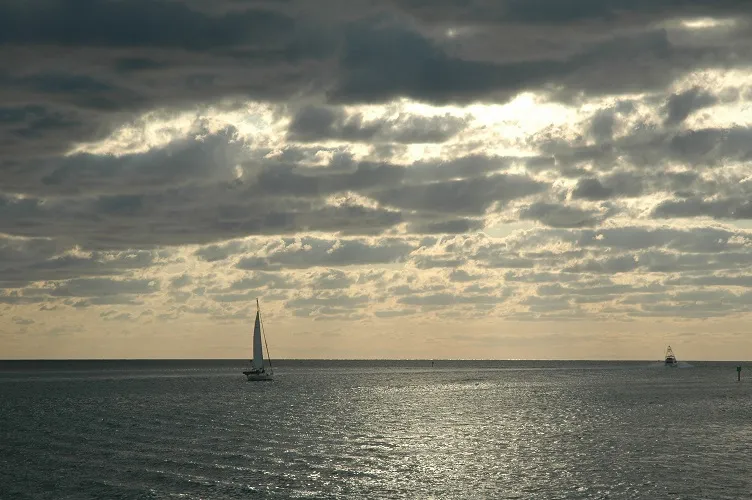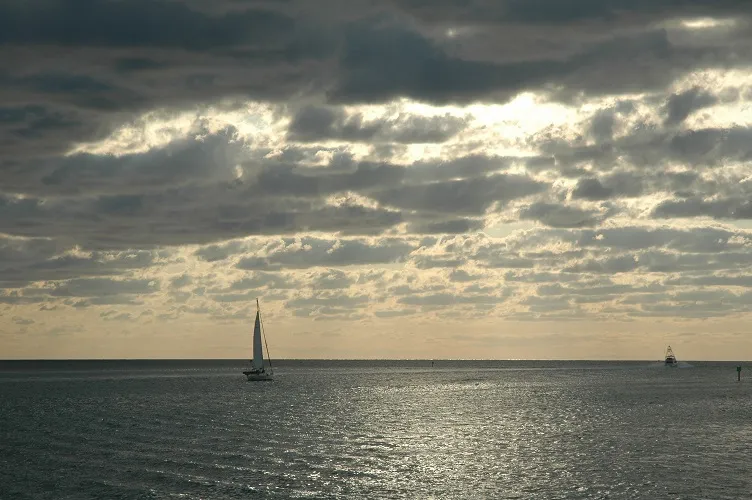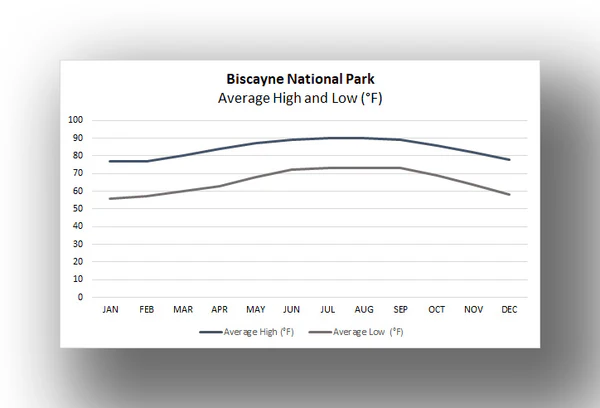
Ultimate Guide to Biscayne National Park Trails: Expert Hiking Adventures in Florida's Hidden Gem
Having explored Biscayne National Park trails for over five years, I can confidently say this unique aquatic wonderland offers some of Florida's most distinctive hiking experiences. From the iconic Jetty Trail overlooking turquoise waters to hidden island pathways, this comprehensive guide reveals everything you need to know about biscayne national park trails, including insider tips, essential gear recommendations, and seasonal insights that will transform your visit into an unforgettable adventure. Nature Guests has compiled this ultimate resource to help you maximize your hiking experience in this 95% underwater national park.
🌊 Overview of Biscayne National Park Trails

When I first discovered biscayne national park trails, I was amazed by their unique character compared to traditional hiking destinations. This remarkable 270-square-mile park, situated just 20 miles south of Miami, offers an extraordinary blend of terrestrial and aquatic hiking experiences that you won't find anywhere else in the National Park System.
The park's five primary trails may seem modest in number, but each offers distinct experiences that showcase the incredible biodiversity of South Florida's coastal ecosystem. From the visitor center's mainland trails to the remote island pathways accessible only by boat, these biscayne national park trails provide intimate encounters with mangrove forests, coral reefs, and pristine beaches.
What sets these trails apart is their integration with the park's aquatic environment. During my countless visits, I've witnessed manatees gliding beneath the Jetty Trail boardwalk, spotted dolphins playing in the distance, and marveled at the crystal-clear waters that reveal sea grass beds and coral formations. The visitor center serves as the perfect starting point for understanding this unique ecosystem.
Each trail in the park tells a different story. The accessible mainland trails offer glimpses into the park's rich maritime history, while the island trails reveal the untouched beauty of the Florida Keys' northernmost reaches. Whether you're seeking a leisurely stroll along the Jetty Trail or an adventurous exploration of Elliott Key's Spite Highway, these biscayne national park trails cater to every hiking preference and skill level.
The park's commitment to conservation means that trail conditions remain pristine, though visitors should prepare for the unique challenges of coastal hiking. From intense sun exposure to persistent mosquitoes, understanding these environmental factors will ensure your biscayne national park trails experience exceeds expectations rather than disappoints.
🥾 The Famous Jetty Trail Experience
The Jetty Trail stands as the crown jewel of biscayne national park trails, offering an unforgettable 0.8-mile round-trip journey that I consider essential for every park visitor. This remarkable trail begins at the Dante Fascell Visitor Center and extends along a historic jetty into the pristine waters of Biscayne Bay.
During my first walk along this trail, I was immediately struck by its unique construction. The path seamlessly transitions from paved walkways to elevated boardwalks and finally to the substantial concrete jetty itself. This engineering marvel not only provides safe passage over the water but also creates an intimate connection with the marine environment that defines Biscayne National Park.
What makes the Jetty Trail truly special among biscayne national park trails is its ability to provide both educational and recreational value. The trail features ten interpretive stations, each offering insights into the park's diverse ecosystems, maritime history, and conservation efforts. I've spent countless hours at these stations, learning about the delicate balance between development and preservation that shapes this unique landscape.
The trail's accessibility makes it perfect for families, with its flat terrain and well-maintained surfaces accommodating visitors of all ages and abilities. However, don't let its ease fool you into thinking it's merely a casual stroll. The Jetty Trail offers some of the most spectacular viewing opportunities in the park, with panoramic vistas of Biscayne Bay, the distant Miami skyline, and the endless expanse of the Atlantic Ocean.
Wildlife encounters along the Jetty Trail are frequent and memorable. I've witnessed manatees surfacing just below the boardwalk, pelicans diving for fish in the nearby waters, and countless species of tropical fish visible through the crystal-clear water. The trail's end provides an excellent vantage point for photographing boats navigating the bay and observing the park's famous coral reefs in the distance.
🎯 Pro Tip for Jetty Trail Success
Visit during early morning or late afternoon for the best wildlife viewing opportunities and optimal lighting conditions. The trail can become quite hot during midday hours, so plan accordingly with proper sun protection.
🏝️ Island Trail Adventures

The island trails represent the true adventure component of biscayne national park trails, accessible only by boat and offering an authentic wilderness experience in the heart of the Florida Keys. During my numerous island expeditions, I've discovered that these trails provide the most intimate encounters with the park's pristine ecosystems.
Elliott Key: The Spite Highway Trail
Elliott Key hosts the longest trail in the park system, the infamous Spite Highway Trail stretching 7 miles one-way through the island's center. This trail earned its name from a developer's attempt to prevent the area's designation as a national park by clear-cutting a six-lane swath through the island's pristine forest. Today, this historical scar serves as a fascinating hiking corridor that tells the story of conservation triumph over commercial development.
Walking the Spite Highway Trail requires serious preparation and commitment. The flat, sandy path offers little shade and can become intensely hot during midday hours. However, the trail rewards dedicated hikers with opportunities to observe the island's recovering ecosystem and spot wildlife that has returned to reclaim this once-devastated area.
Boca Chita Key: Historic Island Exploration
The Boca Chita Key Trail offers a more accessible island hiking experience among biscayne national park trails. This 0.8-mile loop trail provides excellent opportunities to explore the island's rich history, including the iconic Boca Chita Lighthouse that serves as a landmark visible from miles away across the bay.
What I find most compelling about this trail is its perfect balance of natural beauty and historical significance. The path winds through coastal hammock vegetation, past the remnants of early 20th-century development, and offers stunning views of the surrounding waters. The diverse attractions found throughout the national park system pale in comparison to this unique maritime experience.
Adams Key: The Quiet Retreat
Adams Key Loop Trail represents the most peaceful option among biscayne national park trails, offering a brief 0.5-mile walk through the island's tropical hammock. This trail provides excellent opportunities for bird watching and experiencing the serene beauty of an undeveloped Florida Key.
The trail's proximity to Jones Lagoon makes it an excellent base for kayaking and paddleboarding adventures. I've often combined hiking this trail with water activities, creating full-day adventures that showcase both the terrestrial and aquatic aspects of the park's diverse ecosystem.
🚤 Island Access Information
All island trails require boat transportation. Consider booking tours through the Biscayne National Park Institute or bringing your own watercraft. Check weather conditions and tide schedules before planning your island trail adventures.
🎒 Essential Gear & Preparation
Proper preparation makes the difference between an enjoyable adventure and a challenging ordeal when exploring biscayne national park trails. Through years of experience hiking these unique coastal paths, I've refined my gear recommendations to ensure every visitor can safely and comfortably enjoy these remarkable trails.
☀️ Sun Protection Essentials
The intense South Florida sun reflects off both water and sand, creating challenging conditions for hikers. Reef-safe sunscreen is absolutely essential, not only for your protection but also for preserving the delicate coral ecosystems that make this park special.
🧴 Sun Bum Reef-Safe Sunscreen SPF 50
My go-to choice for protecting both skin and coral reefs during long trail days.
$17.49
🦟 Insect Protection
Mosquitoes and other biting insects are persistent throughout the year in Biscayne National Park, particularly on the island trails. Quality insect repellent is non-negotiable for comfortable hiking experiences.
🚫 Repel 100 Insect Repellent
Maximum protection DEET formula that lasts through long hiking days and humid conditions.
$7.48
📱 Water Protection
The combination of water activities and trail hiking in biscayne national park trails requires reliable protection for electronic devices. A quality waterproof phone case is essential for both safety and capturing memories.
💧 Pelican Marine Waterproof Phone Case
Floating design with crystal-clear window for photography and touch screen access.
$34.99
🏃♂️ Quick-Dry Essentials
The humid coastal environment and frequent water exposure make quick-dry gear essential for comfort during and after exploring biscayne national park trails. Microfiber towels are particularly valuable for their compact size and superior absorbency.
🏖️ Rainleaf Microfiber Travel Towel
Ultra-lightweight and compact design perfect for trail hiking and water activities.
$8.99
Additional gear considerations include sturdy water shoes for navigating rocky shorelines, a wide-brimmed hat for extended sun protection, and a lightweight daypack for carrying essentials during longer trail excursions. The comprehensive gear approach ensures you're prepared for any situation that might arise during your park adventure.
📅 Seasonal Hiking Guide

Understanding seasonal variations is crucial for maximizing your experience with biscayne national park trails. Each season brings unique opportunities and challenges that can significantly impact your hiking adventures in this coastal paradise.
🌸 Spring (March-May): Peak Hiking Season
Spring represents the absolute best time for exploring biscayne national park trails, with comfortable temperatures averaging 75-85°F and lower humidity levels. During my spring visits, I've consistently enjoyed perfect hiking conditions with minimal insect activity and exceptional wildlife viewing opportunities.
The park's flora reaches peak beauty during spring months, with blooming native plants creating spectacular displays throughout the trail system. Water clarity reaches its seasonal best, making this an ideal time for combining trail hiking with snorkeling and diving activities. However, spring is also the busiest season, so plan early morning trail visits to avoid crowds.
☀️ Summer (June-August): The Challenge Season
Summer hiking in biscayne national park trails demands serious preparation and respect for the intense heat and humidity. Temperatures regularly exceed 90°F with humidity levels that can make outdoor activities uncomfortable for unprepared visitors.
Despite the challenging conditions, summer offers unique rewards for dedicated hikers. The park's camping fees are waived during these months, and you'll encounter fewer crowds on the trails. Early morning and late afternoon hiking sessions provide the best compromise between comfort and trail access. The portable camping equipment becomes essential for extended stays during summer months.
🍂 Fall (September-November): Hurricane Season Considerations
Fall brings the Atlantic hurricane season's peak activity, requiring flexible planning for biscayne national park trails adventures. While weather conditions can be unpredictable, periods between tropical systems often provide excellent hiking opportunities with reduced crowds and comfortable temperatures.
This season offers some of the park's most dramatic weather displays, with spectacular sunsets and dynamic cloud formations creating photographic opportunities. However, always monitor weather forecasts and park closures before planning fall hiking trips.
❄️ Winter (December-February): The Comfortable Season
Winter provides the most comfortable hiking conditions for biscayne national park trails, with temperatures ranging from 65-75°F and minimal humidity. This season attracts many visitors seeking relief from northern winters, making early morning trail access particularly valuable.
Wildlife activity increases during winter months as many species take advantage of the cooler temperatures. Manatees become more active in the warmer bay waters, and bird migration patterns bring diverse species to the park's ecosystems. Winter represents an excellent time for combining multiple trail experiences into comprehensive park visits.
🎯 Year-Round Trail Tips
- Always check park alerts and weather conditions before visiting
- Bring more water than you think you'll need
- Plan for sudden weather changes typical of coastal environments
- Consider tide schedules when planning island trail visits
The seasonal diversity of biscayne national park trails means that repeat visits throughout the year reveal new aspects of this remarkable ecosystem. Each season offers unique perspectives on the park's natural beauty and presents different opportunities for wildlife encounters and outdoor adventures.
✨ Conclusion
After years of exploring biscayne national park trails, I remain continually amazed by the unique experiences this remarkable park offers. From the accessible beauty of the Jetty Trail to the wild adventure of Elliott Key's remote pathways, these trails provide unparalleled opportunities to connect with South Florida's pristine coastal ecosystem.
The park's five distinct trails may seem modest compared to other national parks, but their integration with the surrounding aquatic environment creates hiking experiences that are truly one-of-a-kind. Whether you're watching manatees from the Jetty Trail boardwalk, exploring the historical remnants on Boca Chita Key, or challenging yourself with the full length of the Spite Highway Trail, each path offers its own rewards and discoveries.
Success in exploring biscayne national park trails depends on proper preparation, seasonal awareness, and respect for the delicate ecosystems you'll encounter. The gear recommendations, seasonal insights, and practical tips I've shared come from real experience and will help ensure your adventures are both safe and memorable.
Remember that this park represents more than just hiking trails – it's a living laboratory where conservation efforts protect some of the world's most important marine ecosystems. By visiting responsibly and supporting these conservation efforts, you become part of the ongoing story of preserving this incredible natural treasure for future generations.
The magic of biscayne national park trails lies not just in their scenic beauty or wildlife encounters, but in their ability to connect us with the complex relationships between land and sea that define South Florida's unique character. Each visit reveals new layers of understanding about this remarkable ecosystem and our role in protecting it.
Plan your visit to Biscayne National Park trails with confidence, knowing that you're equipped with the knowledge and preparation necessary for an unforgettable adventure. This hidden gem of the National Park System awaits your discovery, offering experiences that will create lasting memories and foster a deeper appreciation for the natural world's incredible diversity and beauty.
🌟 Ready to Start Your Adventure?
Begin planning your biscayne national park trails experience today with proper gear and preparation. Your next great outdoor adventure awaits!
🛒 Shop Essential Gear 🌿 More Park Guides
